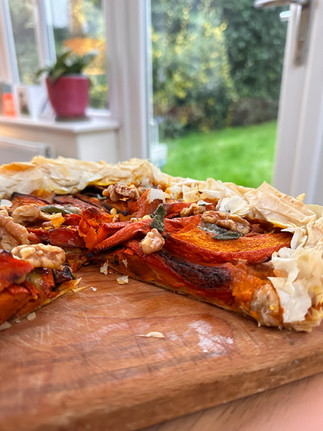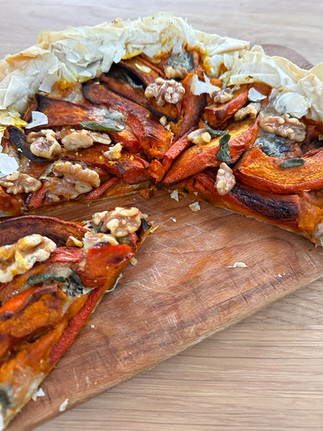Onion Squash & Gorgonzola Tart Recipe
- Felicity Vincent

- Nov 2, 2024
- 4 min read
Updated: Jan 2
All the flavours of Autumn in a comforting tart.
Crispy base of flaky filo pastry topped with a squash and gorgonzola cream, roasted onion squash, crunchy walnuts and crispy sage leaves. The perfect autumnal centrepiece, an easy recipe packed full of tasty goodness.

Ingredients (serves 4):
Squash & gorgonzola creme recipe:
300g cubed squash (onion squash, pumpkin or butternut squash), approx 1/4
1 white onion
1 Tbs vegetable oil
Pinch of cinnamon
15g gorgonzola
Sea salt
Onion squash & gorgonzola tart recipe:
25g butter
2 Tbs EVOO
5 sheets filo pastry (or shop bought pastry of choice)
1/4 squash (onion squash, pumpkin or butternut)
20g gorgonzola
25g walnuts
7 sage leaves
Method:
Preheat the oven to 180°C.
Start with the creme:
Peel and quarter the white onion.
Quarter the onion squash, then peel and roughly chop into 2-inch cubes.
Toss the onion and the squash in a bit of oil, spread out on a baking tray with a few pinches of salt and cinnamon then roast for 40 minutes or until tender and slightly caramelised.
Using a food processor, blitz the roasted squash and onion with the gorgonzola while its hot, until it's nice and smooth.
Cut the other 1/4 of the squash into nice wedges with the skin still on. Lay out onto a baking tray with a bit of oil and a pinch of salt, roast until tender and golden (about 30 minutes).
Melt the butter in a small bowl then stir in the oil.
Brush this mix onto the sheets of filo pastry, then lay them out in a tart tin, overlaying the sheets and letting some of them hang over the sides.
Cover the base with the creme, then arrange the squash wedges on top. Finish with dollops of gorgonzola, a scattering of walnuts and the sage leaves.
Scrunch up the filo pastry hanging off the tin to create a crust.
Bake in the oven for 50 minutes, or until the filo is golden all over.
Serve hot with a side salad and enjoy. Bon appétit!
More about this onion squash recipe:
Shortcuts:
Use any pumpkins you find/like: leftover carved pumpkins, butternut squash, etc. I’ve used onion squash because it’s my favourite and has a very vibrant colour.
Use shop bought puff pastry, it’s more indulgent but saves on having to layer the filo.
Keys to success:
This recipe is very simple, but feel free to message me if you have any questions.
Health benefits of winter squash:
They're a good source of:
vitamin B7 (biotin) which supports cell health and is needed to transform food into energy;
vitamin C which acts as a water-soluble antioxidant, protects cells, enables wound healing and helps maintain healthy skin, bones, cartilage and blood vessels; it is also required to convert dopamine to noradrenaline;
soluble fibre which helps lower blood cholesterol, and slows the release of energy from food, managing blood sugar levels. It also helps bulk stools with water and serves as a prebiotic, meaning it feeds our gut bacteria for a healthy microbiome which has its own multitude of health benefits;
insoluble fibre - helps to make you feel full, and soften stools for better digestive health. It is also associated with phenolic compounds and therefore antioxidant properties.
Winter squashes also contain many other beneficial active compounds. Most notably they get their lovely orange colour from carotenoids in the flesh and sometimes skin. But let's take a closer look at their benefits:
Beta-carotene (pigment)- converted to vitamin A to support eye health, skin health, and the immune system. It accumulates under the skin, protecting us from UV rays and potentially reducing the risk of skin cancer. Vitamin A is also required for the formation of keratin to support teeth health. Beta carotene has also been suggested to have protective affects on our liver.
Zeaxanthin (pigment) - also acts as an antioxidant in our eye's retina, preventing macular degeneration. Helps prevent cancer like all other antioxidants but also protects your eyes from ageing, protects your skin from UV, and some research indicates it may be beneficial to cognitive function.
Lutein (pigment) - has been proven to support eye health. It may slow down the effects of age-related vision loss and cataracts. Its anti-inflammatory properties may also support cognitive function and a decreased risk of cancers and cardiovascular diseases.
Beta-cryptoxanthin (pigment) - a derivative of beta-carotene. This antioxidant also has anti-obesity, anti-cancer and anti-inflammatory properties that in part help to protect joints from aging-related aches such as rheumatoid arthritis.
Quercetin (polyphenol) -It may support heart health and lower high blood pressure, and has also been noted to reduce harmful bacterial growth and support the immune system in combatting viral infections and reducing allergy symptoms, as well as protecting against degenerative brain disorders.
Caffeic Acid (polyphenol) -anti-tumor properties and promising signs towards the prevention of osteoporosis.
Gallic Acid (polyphenol) - has also been shown to support heart health.
Ferulic Acid (polyphenol) - has been shown to reduce the risk of cardiovascular disease and lower blood pressure (only in individuals with high blood pressure). It was also shown to improve liver health in animal studies. Its strong antioxidant properties mean that it helps scavenge free radicals and reduce risk of certain types of cancer, as well as having anti-inflammatory properties. In addition to all this, ferulic acid crosses the blood brain barrier and has therefore been studied for its antidepressant-like effects.
All these phenolic compounds have antioxidant and anti-inflammatory properties that reduce the risk of developing certain diseases such as cancer, cardiovascular disease and degenerative brain diseases,
I won't go into too much detail about pumpkin seeds but rest assured they are full of nutrients such as protein including the amino acid tryptophan with supports our sleep and mood, unsaturated fats, magnesium and antioxidants.
Mood Food - Focus:
Vitamin C - is involved in converting dopamine to noradrenaline - a hormone associated with alertness, and memory;
Beta carotene - may improve cognitive function over time and alleviate brain fog;
Lutein - anti-inflammatory which supports cognition and alertness;
B Vitamins - help the body release energy from food, contribute to higher alertness and concentration. Not having sufficient B vitamins has been linked with feeling tired;
Hopefully this makes you excited to try this and many other winter squash recipes during their season!
You can find lots of ideas on how to cook with pumpkins in my newsletter: https://felicityvincent.substack.com/
Video:
Cook along with this step-by-step video and learn how to make my easy onion squash recipe.
Photos:

















Comments